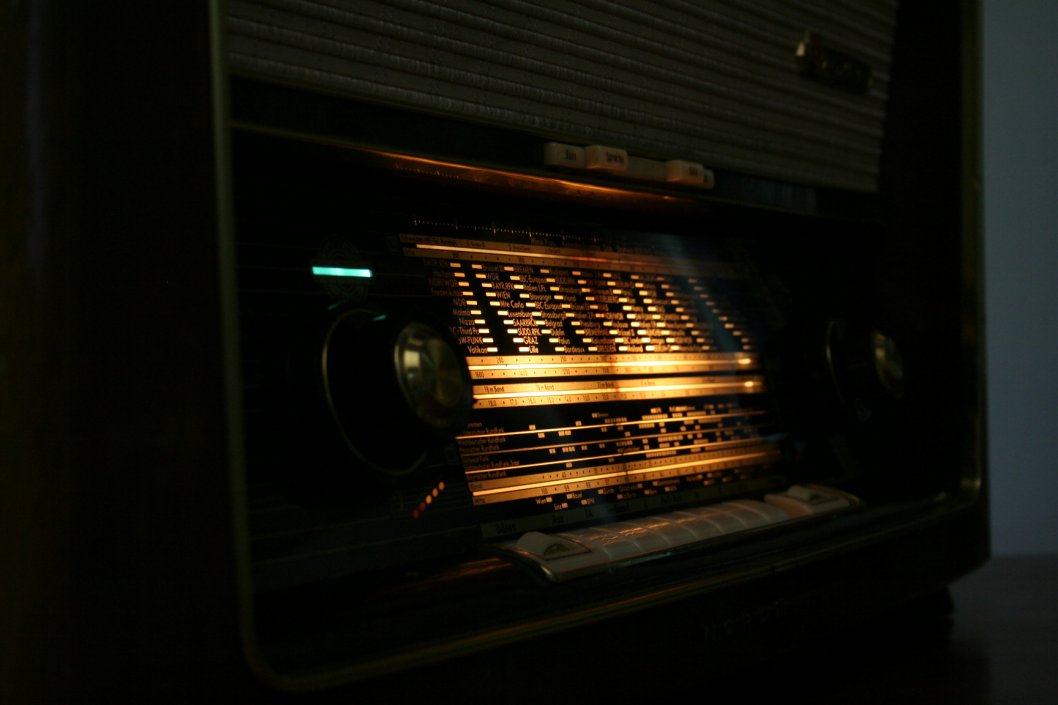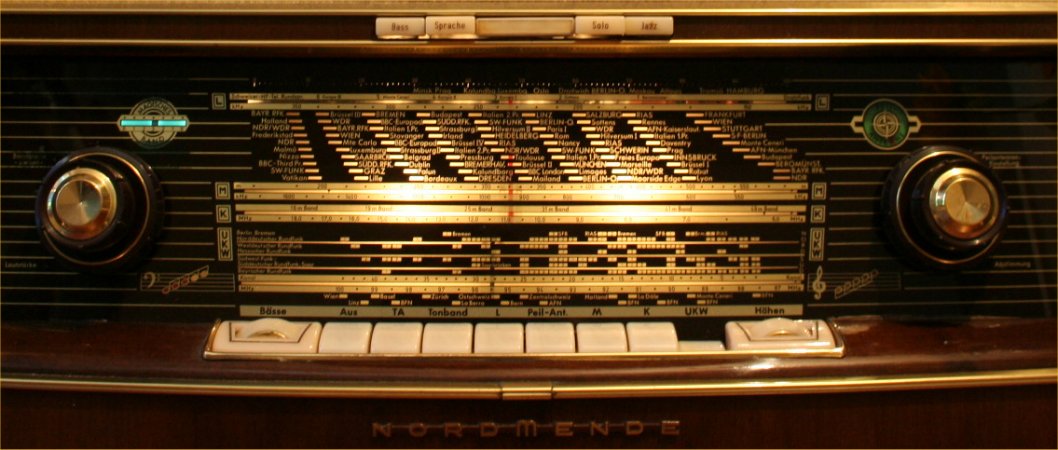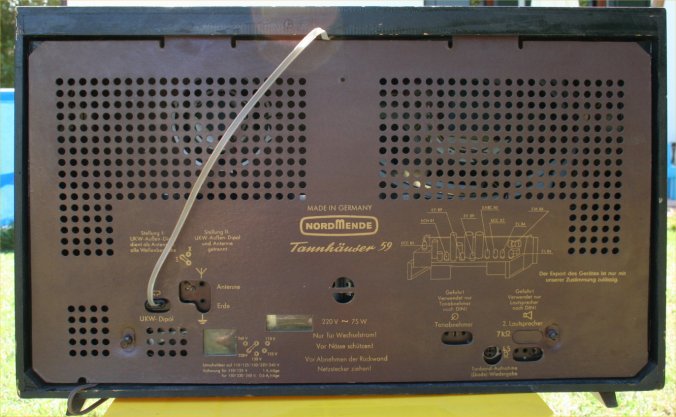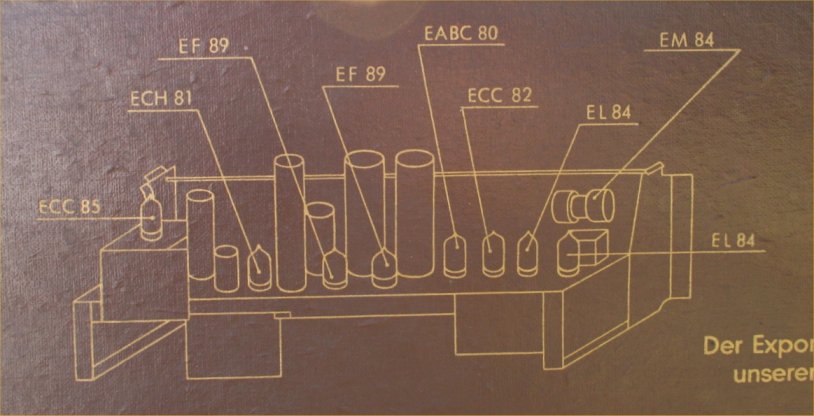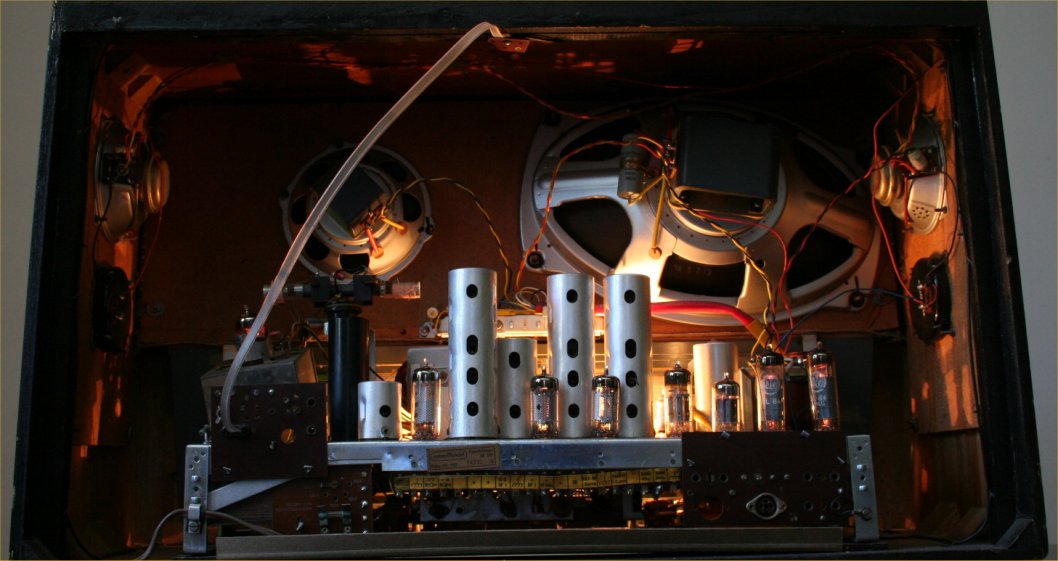 german radios - cn
german radios - cn
Nordmende…
- 17th 6 月 2023
- by giovanni
NORDMENDE TANNHÄUSER 59
Nordmende Tannhäuser 59
Tannhäuser, born into a family of knights in Salzburg, took part maybe in the sixth Crusade of 1228 and led a wandering life as a poet and a bard. He attended the court of Duke Frederick II in Vienna.
According to legend, during his life Tannhäuser found the Venusburg (mount of Venus), the subterranean reign of Venus, and lived with her for one year. He then left the goddess, full of remorse, and undertook a journey to Rome, in order to ask Pope Urban IV for forgiveness. The Pope reminded him that such sins lead to eternal damnation and promised to forgive him only in the event of a miracle: the appearance of flowers on his cane. Three days later Tannhäuser returned to Vienna and the cane bloomed.
The legend was put into music by Richard Wagner in his Tannhäuser.
Nordmende, in its heyday of technological growth, decided to name “Tannhäuser” its best device ever produced.
A device designed to represent the crest of the technical perfection of its time and extreme attention to detail.
The output stage is composed of a pair of EL84 in Push-Pull. The phase inversion is carried out with a section of the double triode ECC82 in Cathodyne configuration. This kind of inverter has an advantage, the possibility to be connected directly to its previous stage. Such stage consists of the remaining section of the double triode ECC82, which provides for the amplification of the signal after the attenuation deriving from the tone control circuit.
The triode contained in the multifunction valve EABC80 constitutes the input preamplifier and receives a signal from a logarithmic potentiometer with 3 intermediate sockets for a complex and very accurate physiological volume control circuit.
The radio section is of the same high quality. An additional medium frequency stage is present, in order to increase the selectivity.
This allows the receipt of transmissions, especially in FM, particularly stable and free from disturbance.
The complex of loudspeakers, moreover, is really impressive. All the loudspeakers are made by Isophon.
The reproduction of low and medium frequencies is ensured by a big elliptic woofer P 2031/19/105 which measures 31 cm in length and 20 in height.
To trebles, instead, are dedicated 5 loudspeakers built with 2 different technologies.
Frontally we have a 13 cm midrange for a soft reproduction, perfectly integrated with that of the woofer.
On each side was placed the famous HM 10/12/70 cone tweeter and an ST HB7 electrostatic tweeter
As Baudelaire wrote, the Tannhäuser represents the struggle between the two principles which choose the human heart as their battlefield, that is the flesh against the spirit.
Nordmende honoured this great piece of work with the realisation of its best product.
Frontally, we can find the famous cone tweeter HM 10/12/70 The trumpet exit of a DKS 6/13/100 and an electrostatic tweeter ST HB7 were put on each side.

BLUETOOTH
Bluetooth receiver embedded
MULTI PLATFORM CONNECTION
Each radio is equipped with a cable for connection to any digital device.
TUBESOUND IMPROVEMENTS
- Bluetooth receiver embedded - The unit is equipped with a BLUETOOTH receiver powered directly by the receiver power supply. This makes it possible to control the amplifier from any external digital device as an IPAD, a Smartphone, or a sophisticated multimedia station. So you can hear your preferred web station or your lossesless file without cables on the room. Wireless Receiver can be equipped upon requests.
- Multi Platform Connection - A customized adaptation cable to connect any digital device as Iphone, Smartphone, Laptop, CD Player etc. will be provided with this radio. This special cable suits the different impedances between the modern equipment and the receiver. Furthermore the two stereo channels flow into one without increasing the load to the input unit.

LA STORIA
In 1923 Otto Hermann Mende founded Radio H. Mende & Co. in Dresden. After the bombing of the factory in 1945, Martin Mende (son of the founder) created a new company in Bremen, the "North German Mende Broadcast GmbH" whose name was later changed into NORDMENDE.
In the 50s and 60s it became one of the most prestigious German TV and radios manufacturer.
In the 70s the televisions by NORDMENDE became famous for their frames, cards and for the rigorous testing and quality controls carried out on their finished products. Unfortunately, the high cost involved in such detailed quality determined a competitive disadvantage when the price of color television began to fall.
In 1977 the majority of the shares was sold to the French Thomson. The following year, the family sold the remaining shares. In 1980, the factories of Bremen was closed, NORDMENDE becoming purely a trademark of Thomson.
Thanks Dan Ludington for the image.
MAIN FEATURES
Year of production: 1958/59
Superheterodyne IF 468/10700
10 AM Circuits
13 FM Circuits
Wavebands:
Medium Waves (OM), Long Waves (OL), Short waves (OC), FM (UKW)
Loudspeakers:
1 woofer
1 cone midrange
2 horn tweeters
2 electrostatic tweeters
Dimensions (LHD):: 700 x 420 x 290 mm / 27.6 x 16.5 x 11.4 inch
Net weight: 16.3 kg / 35 lb 14.4 oz
9 Tubes: ECC85 ECH81 EF89 EF89 EM34 or EM35 EABC80 ECC82 EL84 EL84
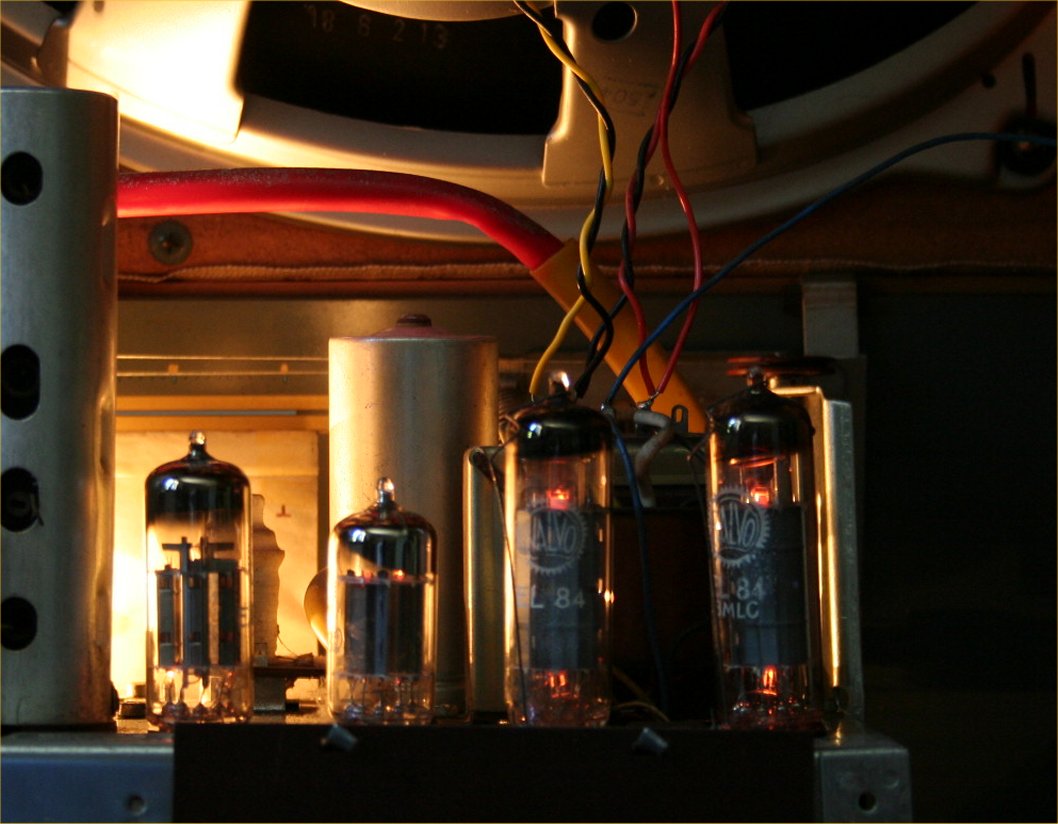
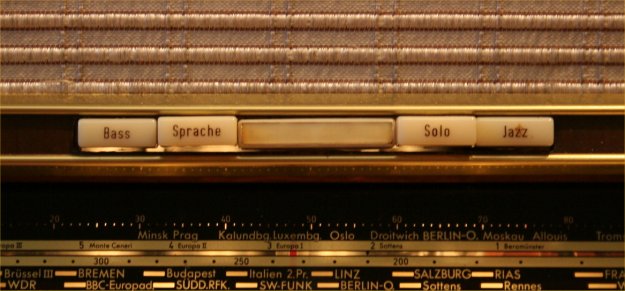
BANDBREITE SCHALTBAR
The device has been equipped with a frequency response correction system independent of the tone controls.
It is made up of 5 keys which insert predefined equalization curves operating on the feedback circuit (they are not passive filters).
The Bass key emphasizes bass tones.
The Sprache key boosts the mid-range for cleaner listening to spoken broadcasts.
The Expander key (the large central one) inserts a feedback curve that slightly favors the mid-bass tones, increasing the sense of space.
The Solo key slightly accentuates the mid-tones for easier listening to single instruments.
The Jazz key greatly emphasizes the low and high tones to facilitate listening to this musical genre.
TONE CONTROL WITH LEVEL INDICATION
The tones control system is very efficient.
Above the large tone control knobs there is a band that lights up gradually indicating the emphasis on the band on which it acts.
The treble control knob is connected to the ferrite in the MF transformers and varies the slope of the transformer bell. In this way, when you are in the AM bands, the treble tones are further accentuated even before arriving in the BF amplifier stage.

BASS MAX

Bass flat
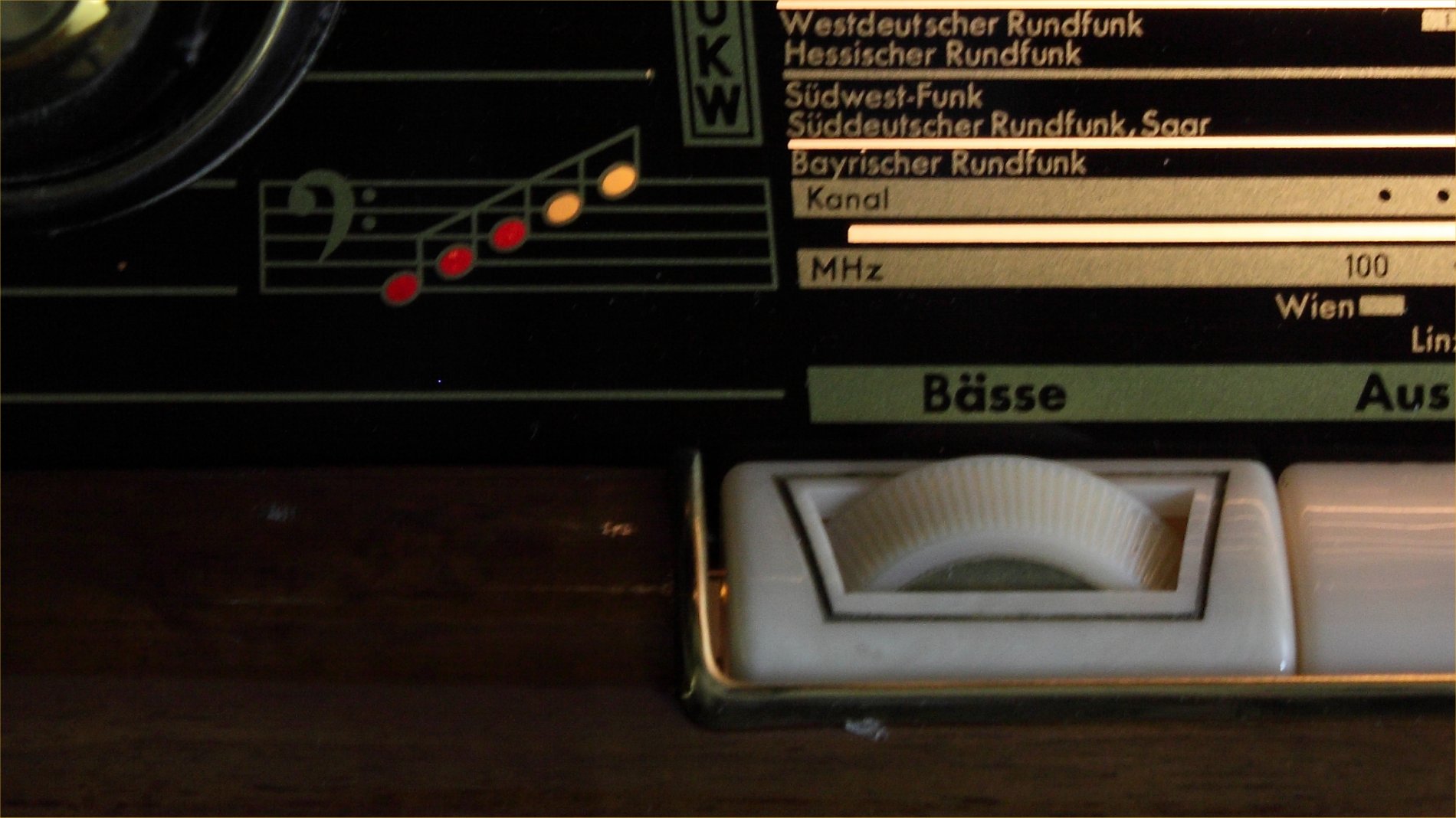
BASS MIN

TREBLE MIN

TREBLE FLAT

TREBLE MAX

ANTENNE
Inside the cabinet there is a dipole for FM reception and a ferrite rotating aerial for AM reception.
Ferrite aerial can be rotated from the outside to achieve a perfect tuning of the device in the AM.
In this picture see the rotation mechanism and the position indicator of the aerial.
The reception sensitivity with internal aerials is very good. This unit was in fact produced in a period when there were not many radio stations and those available fairly apart from each others.
Using an external aerial sensitivity is further increased.
SEPARATE CONTROL TUNING BETWEEN AM AND FM
The tuning system is another gem.
The unit is equipped with mechanisms for keeping separate the AM and FM bands.
The tuning knob is single but a selector switch commutes into cable systems (all in steel) and pulleys separated depending on the band.
The movement is transferred to both mechanisms with a system of pulleys and separated gears.
TUNING INDICATOR

The magic eye has of course been replaced.

ALTOPARLANTI
The loudspeakers are six.
In the front we find the biggest elliptic broadband built by Isophon, very linear and efficient. Also frontally, we find an Isophon cone midrange.
In order to obtain a 3D effect, we find on the sides two cone tweeters with two electrostatic SuperTweeters.
The acoustic performance is really generous.
None of the radios I know has the same dotation of loudspeakers.
Above the dial, in the loudspeakers panel we find the series of buttons of the Bandbreite Schltbar, previously described.
Moving downwards on the tuning-dial, we first find the magical eye, which indicates the perfect tuning of each station. Below, we find the volume control (with integrated loudness).
By pulling the volume knob, the circuit which powers selectivity in the AM bands is inserted.
From the top down are then indicated the AM dial for Long, Medium and Short bands and below we find the FM dial.
Moving further right, we find the indicator of the position of the ferrite aerial.
Finally, there is the tuning knob, which movement is very pleasant as it is supported by a big flywheel.
Coaxial to the harmony knob is the knob which rotates the ferrite aerial.
Below on the left we find the treble control knob set in a nice bakelite casing with ivory effect.
In the following order, then, we find the buttons:
AUS - Off
TA - Turntable
TONBAND - Tape recorder
L - Long Wave
Peil-Ant - Ferrite antenna for LW and MW
M - Medium Wave
K - Short Wave
UKW - FM
On the right, the bass control is visible.
Above the tone controls, the respective emphasis indicators of the controls.



